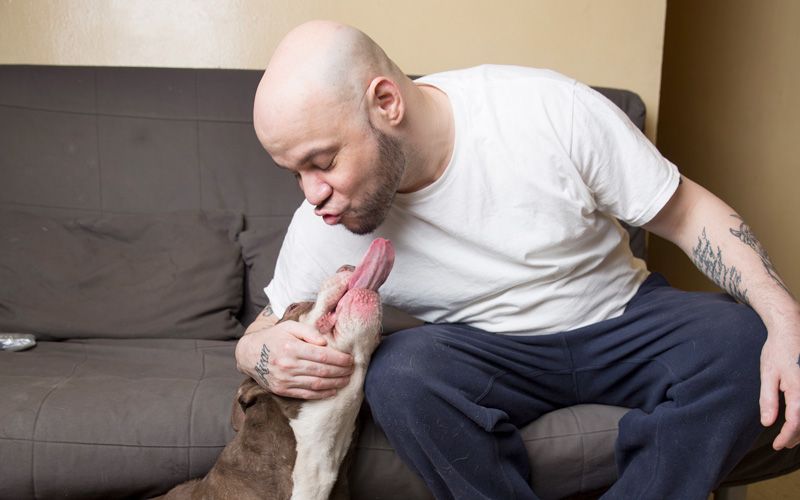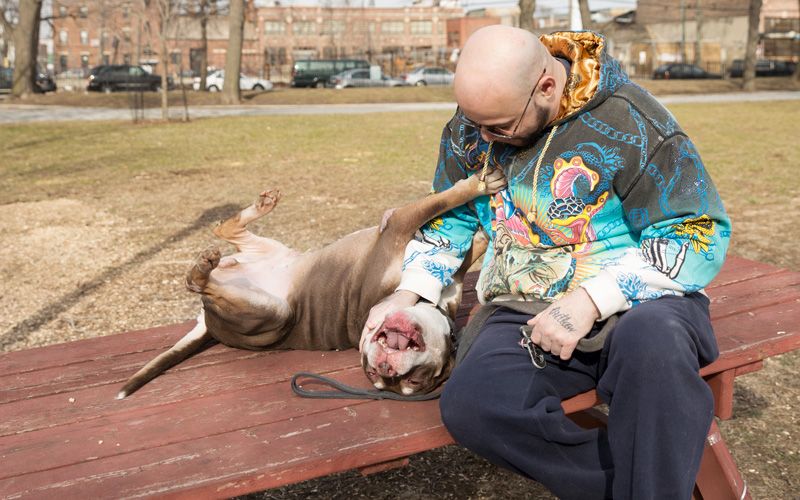Getting by with a little help … from your pet
Federal laws regarding assistance animals can boost your efforts to keep pets in homes

The stories all pretty much follow the same pattern: Resident has dog for years. Resident relies on the dog just to get through the day; maybe, due to depression, the dog is the only reason to get out of bed in the morning, or maybe walking the dog helps with heart disease problems. Resident is suddenly told dogs aren’t allowed in the building—give her up or get out. Heartbroken resident brings dog to shelter.
For some, this is where the story might end, even though people with disabilities have a legal right to assistance animals. But when shelters are aware of the laws, many stories can have a happier ending.
Almost a fifth of Americans have some kind of disability, according to the U.S. Census Bureau. Of course, not everyone with a disability is entitled to an assistance animal, but many people who are might not even realize it.
According to the federal Fair Housing Act (FHA), which would trump any conflicting state or local laws, landlords and housing providers must make a “reasonable accommodation” to allow people with disabilities to have assistance animals—even if the lease doesn’t allow pets.
Federal law defines a disability as a “physical or mental impairment that substantially limits one or more major life activities.” Assistance animals can either perform tasks to help a person (like detecting seizures) or provide emotional support to address the symptoms of a disability.
“The parameters of the statute are so broad that it really does encompass a lot of people,” says Karen Copeland, a lawyer in New York City who specializes in animal law. “The big thing is not only that one has a diagnosed condition, but that a medical professional is willing to make a connection between the keeping of an animal and the condition.”
Copeland says she has seen many unique cases, from a woman with emphysema whose dog distracted her from smoking to a man who said walking and playing with his dog helped minimize the effects of his Parkinson’s disease.
Assistance animals differ from service animals. The latter are specifically trained and allowed in public places because the owner needs the animal at all times (like a guide dog for a blind person); the former aren’t allowed in public places and do not have to be specifically trained to perform a service to their owner.
“The literature that makes the connection to the medical benefits of keeping a pet [is] pretty extensive, and the Fair Housing Act pretty much recognizes that,” says Copeland. An assistance animal can provide “the type of companionship and friendship that one would expect from a pet, except for the disabled person, it becomes so much more.”

In New York, the Animal Care Centers of NYC (ACC NYC) shelters call on the Mayor’s Alliance for NYC’s Animals when these cases come up. Matt Wildman, an HSUS employee who also volunteers for the Mayor’s Alliance, helps with cases and previously did similar work through The HSUS.
The FHA is “just such an underutilized resource, and it’s such a powerful resource,” Wildman says. “Time and again … I just think how many people have surrendered their animal not aware they had a valid claim to their animal as an [assistance] animal.”
The law doesn’t allow for species, breed or size restrictions for assistance animals, whether imposed by the housing provider or local breed-specific legislation. For example, a resident can legally keep a pit bull-type dog who is an assistance animal, even if the landlord or city normally bans them.
Contrary to what many people believe, assistance animals don’t need to be registered or certified. Tenants simply need to give their landlord or housing provider a note from a health care provider stating that they suffer from a disability and explaining how the animal helps them cope with the disability or alleviate its symptoms. The tenant should also write a note requesting “reasonable accommodation” to keep the pet.
It’s an interactive process, so residents shouldn’t be put off if a landlord comes back with questions. But if the landlord refuses the request or doesn’t respond to it in a reasonable amount of time, the tenant can file a complaint with the U.S. Department of Housing and Urban Development. Usually, just the potential for a complaint is persuasive—Wildman has had to follow through only a few times in six years of working on these cases.
“When everything is said and done, the law is the law, and once the landlord realizes that and realizes that they are putting themselves in danger of a possible discrimination suit, they’re amenable to allowing the animal,” Wildman says.
A landlord can deny a request if it’s not deemed “reasonable”—for example, if the landlord can prove it will cause a large financial burden or that the specific animal is dangerous or a nuisance.
Aleah Simpson, ACC NYC manager of admissions and surrender prevention programming, says that when she first informs clients about their rights, some have a hard time believing the laws can help them.
But in these cases, “the law is on people’s side,” says Wildman.
Recently, Wildman helped a veteran with post-traumatic stress disorder keep his dog after the management of his public housing building told residents they had to get rid of their dogs. The man was in a panic, but Wildman helped him get a letter from his doctor and expects the situation to be resolved smoothly.
Happily, Wildman says most of his stories follow that pattern and provide a new twist on the old scenario: Resident brings dog to shelter. Resident learns that the law gives him the right to keep his pet. Resident and pet live healthier and happier together.







